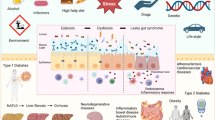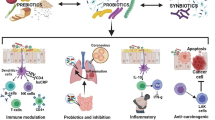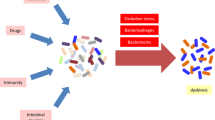Abstract
Background
Uric acid (UA) has anti- and pro-inflammatory properties. We previously revealed that elevated serum UA levels provide protection against murine small intestinal injury probably via luminal UA secreted in the small intestine. Luminal UA may act as an antioxidant, preventing microbiota vulnerability to oxidative stress. However, whether luminal UA is increased under hyperuricemia and plays a protective role in a dose-dependent manner as well as the mechanism by which luminal UA exerts its protective effects on enteropathy remains unknown.
Methods
Inosinic acid (IMP) (1000 mg/kg, i.p.) was administered to obtain high serum UA (HUA) and moderate serum UA (500 mg/kg IMP, i.p.) mice. UA concentrations and levels of oxidative stress markers in the serum and intestine were measured. Mice received indomethacin (20 mg/kg, i.p.) to evaluate the effects of UA on indomethacin-induced enteropathy. Reactive oxygen species (ROS) on the ileal mucosa were analyzed. The fecal microbiota of HUA mice was transplanted to investigate its effect on indomethacin-induced enteropathy.
Results
IMP increased luminal UA dose-dependently, with higher levels of luminal antioxidant markers. Indomethacin-induced enteropathy was significantly ameliorated in both UA-elevated groups, with decreased indomethacin-induced luminal ROS. The microbiota of HUA mice showed a significant increase in α-diversity and a significant difference in β-diversity from the control. Fecal microbiota transplantation from HUA mice ameliorated indomethacin-induced enteropathy.
Conclusions
The protective role of luminal UA in intestinal injury is likely exerted via oxidative stress elimination and microbiota composition modulation, preferably for gut immunity. Therefore, enhancing anaerobic conditions using antioxidants is a potential therapeutic target.





Similar content being viewed by others
References
Oda M, Satta Y, Takenaka O, Takahata N. Loss of urate oxidase activity in hominoids and its evolutionary implications. Mol Biol Evol 2002;19:640–653
Hediger MA, Johnson RJ, Miyazaki H, Endou H. Molecular physiology of urate transport. Physiology (Bethesda) 2005;20:125–133
Sorensen LB. Role of the intestinal tract in the elimination of uric acid. Arthritis Rheum 1965;8:694–706
Matsuo H, Takada T, Ichida K, Nakamura T, Nakayama A, Ikebuchi Y et al. Common defects of ABCG2, a high-capacity urate exporter, cause gout: a function-based genetic analysis in a Japanese population. Sci Transl Med. 2009;1:5ra11
Takada T, Ichida K, Matsuo H, Nakayama A, Murakami K, Yamanashi Y et al. ABCG2 dysfunction increases serum uric acid by decreased intestinal urate excretion. Nucleosides Nucleotides Nucl Acids 2014;33:275–281
Hosomi A, Nakanishi T, Fujita T, Tamai I. Extra-renal elimination of uric acid via intestinal efflux transporter BCRP/ABCG2. PLoS ONE 2012;7:e30456
Ichida K, Matsuo H, Takada T, Nakayama A, Murakami K, Shimizu T et al. Decreased extra-renal urate excretion is a common cause of hyperuricemia. Nat Commun 2012;3:764
Muraoka S, Miura T. Inhibition by uric acid of free radicals that damage biological molecules. Pharmacol Toxicol 2003;93:284–289
Whiteman M, Ketsawatsakul U, Halliwell B. A reassessment of the peroxynitrite scavenging activity of uric acid. Ann N Y Acad Sci 2002;962:242–259
Ames BN, Cathcart R, Schwiers E, Hochstein P. Uric acid provides an antioxidant defense in humans against oxidant- and radical-caused aging and cancer: a hypothesis. Proc Natl Acad Sci U S A 1981;78:6858–6862
Matsuo H, Tomiyama H, Satake W, Chiba T, Onoue H, Kawamura Y et al. ABCG2 variant has opposing effects on onset ages of Parkinson’s disease and gout. Ann Clin Transl Neurol 2015;2:302–306
Toncev G, Milicic B, Toncev S, Samardzic G. Serum uric acid levels in multiple sclerosis patients correlate with activity of disease and blood-brain barrier dysfunction. Eur J Neurol 2002;9:221–226
Scheepers L, Jacobsson LTH, Kern S, Johansson L, Dehlin M, Skoog I. Urate and risk of Alzheimer’s disease and vascular dementia: a population-based study. Alzheimers Dement 2019;15:754–763
Yasutake Y, Tomita K, Higashiyama M, Furuhashi H, Shirakabe K, Takajo T et al. Uric acid ameliorates indomethacin-induced enteropathy in mice through its antioxidant activity. J Gastroenterol Hepatol 2017;32:1839–1845
Roumeliotis S, Roumeliotis A, Dounousi E, Eleftheriadis T, Liakopoulos V. Dietary antioxidant supplements and uric acid in chronic kidney disease: a review. Nutrients 2019;11:1911
Verdecchia P, Schillaci G, Reboldi G, Santeusanio F, Porcellati C, Brunetti P. Relation between serum uric acid and risk of cardiovascular disease in essential hypertension. The PIUMA study. Hypertension 2000;36:1072–1078
Mazza A, Zamboni S, Rizzato E, Pessina AC, Tikhonoff V, Schiavon L et al. Serum uric acid shows a J-shaped trend with coronary mortality in non-insulin-dependent diabetic elderly people. The CArdiovascular STudy in the ELderly (CASTEL). Acta Diabetolog 2007;44:99–105
Perez-Ruiz F, Dalbeth N, Bardin T. A review of uric acid, crystal deposition disease, and gout. Adv Ther 2015;32:31–41
Szekanecz Z, Szamosi S, Kovacs GE, Kocsis E, Benko S. The NLRP3 inflammasome—interleukin 1 pathway as a therapeutic target in gout. Arch Biochem Biophys 2019;670:82–93
Wong TY. Smog induces oxidative stress and microbiota disruption. J Food Drug Anal 2017;25:235–244
Sartor RB, Wu GD. Roles for intestinal bacteria, viruses, and fungi in pathogenesis of inflammatory bowel diseases and therapeutic approaches. Gastroenterology 2017;152:327–39.e4
Scott GS, Spitsin SV, Kean RB, Mikheeva T, Koprowski H, Hooper DC. Therapeutic intervention in experimental allergic encephalomyelitis by administration of uric acid precursors. Proc Natl Acad Sci U S A 2002;99:16303–16308
Morimoto M, Hashimoto T, Kitaoka T, Kyotani S. Impact of oxidative stress and newer antiepileptic drugs on the albumin and cortisol value in severe motor and intellectual disabilities with epilepsy. J Clin Med Res 2018;10:137–145
Sone R, Matsuba K, Tahara R, Eda N, Kosaki K, Jesmin S et al. Assessment of salivary nitric oxide levels in elite university athletes in Japan: findings from a cross sectional study design. J Clin Med Res 2019;11:114–120
Narimatsu K, Higashiyama M, Kurihara C, Takajo T, Maruta K, Yasutake Y et al. Toll-like receptor (TLR) 2 agonists ameliorate indomethacin-induced murine ileitis by suppressing the TLR4 signaling. J Gastroenterol Hepatol 2015;30:1610–1617
Yoshikawa K, Kurihara C, Furuhashi H, Takajo T, Maruta K, Yasutake Y et al. Psychological stress exacerbates NSAID-induced small bowel injury by inducing changes in intestinal microbiota and permeability via glucocorticoid receptor signaling. J Gastroenterol 2017;52:61–71
Chiu CJ, McArdle AH, Brown R, Scott HJ, Gurd FN. Intestinal mucosal lesion in low-flow states. I. A morphological, hemodynamic, and metabolic reappraisal. Arch Surg (Chicago, Ill: 1960) 1970;101:478–83
Higashiyama M, Hokari R, Kurihara C, Ueda T, Watanabe C, Tomita K et al. Indomethacin-induced small intestinal injury is ameliorated by cilostazol, a specific PDE-3 inhibitor. Scand J Gastroenterol 2012;47:993–1002
Ishida T, Miki I, Tanahashi T, Yagi S, Kondo Y, Inoue J et al. Effect of 18beta-glycyrrhetinic acid and hydroxypropyl gammacyclodextrin complex on indomethacin-induced small intestinal injury in mice. Eur J Pharmacol 2013;714:125–131
Higashimori A, Watanabe T, Nadatani Y, Takeda S, Otani K, Tanigawa T et al. Mechanisms of NLRP3 inflammasome activation and its role in NSAID-induced enteropathy. Mucosal Immunol 2016;9:659–668
Ueda T, Hokari R, Higashiyama M, Yasutake Y, Maruta K, Kurihara C et al. Beneficial effect of an omega-6 PUFA-rich diet in non-steroidal anti-inflammatory drug-induced mucosal damage in the murine small intestine. World J Gastroenterol 2015;21:177–186
Tomita T, Sadakata H, Tamura M, Matsui H. Indomethacin-induced generation of reactive oxygen species leads to epithelial cell injury before the formation of intestinal lesions in mice. J Physiol Pharmacol Off J Pol Physiol Soc 2014;65:435–440
Takajo T, Tomita K, Tsuchihashi H, Enomoto S, Tanichi M, Toda H et al. Depression promotes the onset of irritable bowel syndrome through unique dysbiosis in rats. Gut Liver 2019;13:325–332
Jinno S, Toshimitsu T, Nakamura Y, Kubota T, Igoshi Y, Ozawa N et al. Maternal prebiotic ingestion increased the number of fecal bifidobacteria in pregnant women but not in their neonates aged one month. Nutrients 2017;9:196
Caporaso JG, Lauber CL, Walters WA, Berg-Lyons D, Huntley J, Fierer N et al. Ultra-high-throughput microbial community analysis on the Illumina HiSeq and MiSeq platforms. ISME J 2012;6:1621–1624
Caporaso JG, Kuczynski J, Stombaugh J, Bittinger K, Bushman FD, Costello EK et al. QIIME allows analysis of high-throughput community sequencing data. Nat Methods 2010;7:335–336
Gregory JC, Buffa JA, Org E, Wang Z, Levison BS, Zhu W et al. Transmission of atherosclerosis susceptibility with gut microbial transplantation. J Biol Chem 2015;290:5647–5660
Wang Z, Klipfell E, Bennett BJ, Koeth R, Levison BS, Dugar B et al. Gut flora metabolism of phosphatidylcholine promotes cardiovascular disease. Nature 2011;472:57–63
Collins SM. Stress and the gastrointestinal tract IV. Modulation of intestinal inflammation by stress: basic mechanisms and clinical relevance. Am J Physiol Gastrointest Liver Physiol 2001;280:G315–G318
Furuhashi T, Sugitate K, Nakai T, Jikumaru Y, Ishihara G. Rapid profiling method for mammalian feces short chain fatty acids by GC-MS. Anal Biochem 2018;543:51–54
Syer SD, Blackler RW, Martin R, de Palma G, Rossi L, Verdu E et al. NSAID enteropathy and bacteria: a complicated relationship. J Gastroenterol 2015;50:387–393
Heeney DD, Gareau MG, Marco ML. Intestinal Lactobacillus in health and disease, a driver or just along for the ride? Curr Opin Biotechnol 2018;49:140–147
Abell GC, Cooke CM, Bennett CN, Conlon MA, McOrist AL. Phylotypes related to Ruminococcus bromii are abundant in the large bowel of humans and increase in response to a diet high in resistant starch. FEMS Microbiol Ecol 2008;66:505–515
Pitcher MC, Beatty ER, Cummings JH. The contribution of sulphate reducing bacteria and 5-aminosalicylic acid to faecal sulphide in patients with ulcerative colitis. Gut 2000;46:64–72
So A, Thorens B. Uric acid transport and disease. J Clin Invest 2010;120:1791–1799
Misawa T, Takahama M, Kozaki T, Lee H, Zou J, Saitoh T et al. Microtubule-driven spatial arrangement of mitochondria promotes activation of the NLRP3 inflammasome. Nat Immunol 2013;14:454–460
Higuchi K, Umegaki E, Watanabe T, Yoda Y, Morita E, Murano M et al. Present status and strategy of NSAIDs-induced small bowel injury. J Gastroenterol 2009;44:879–888
Kim YJ, Kim EH, Hahm KB. Oxidative stress in inflammation-based gastrointestinal tract diseases: challenges and opportunities. J Gastroenterol Hepatol 2012;27:1004–1010
Duncan SH, Belenguer A, Holtrop G, Johnstone AM, Flint HJ, Lobley GE. Reduced dietary intake of carbohydrates by obese subjects results in decreased concentrations of butyrate and butyrate-producing bacteria in feces. Appl Environ Microbiol 2007;73:1073–1078
Frank DN, St Amand AL, Feldman RA, Boedeker EC, Harpaz N, Pace NR. Molecular-phylogenetic characterization of microbial community imbalances in human inflammatory bowel diseases. Proc Natl Acad Sci U S A 2007;104:13780–13785
Ijssennagger N, van der Meer R, van Mil SWC. Sulfide as a mucus barrier-breaker in inflammatory bowel disease? Trends Mol Med 2016;22:190–199
Shin HS, Satsu H, Bae MJ, Totsuka M, Shimizu M. Catechol groups enable reactive oxygen species scavenging-mediated suppression of PKD-NFkappaB-IL-8 signaling pathway by chlorogenic and caffeic acids in human intestinal cells. Nutrients 2017;9:165
Hiramatsu Y, Satho T, Irie K, Shiimura S, Okuno T, Sharmin T et al. Differences in TLR9-dependent inhibitory effects of H(2)O(2)-induced IL-8 secretion and NF-kappa B/I kappa B-alpha system activation by genomic DNA from five Lactobacillus species. Microbes Infect 2013;15:96–104
Shao BZ, Xu ZQ, Han BZ, Su DF, Liu C. NLRP3 inflammasome and its inhibitors: a review. Front Pharmacol 2015;6:262
Acknowledgments
This research was supported by a Health and Labour Sciences research grant for research on intractable diseases from the Ministry of Health, Labour and Welfare, Japan. We thank Hanae Tsuchihashi (Meiji Co., Ltd.) for the technical support provided during the analysis of the microbiota.
Author information
Authors and Affiliations
Corresponding author
Ethics declarations
Conflict of interest
Ryota Hokari received commercial research funding from EA Pharma Co.
Additional information
Publisher's Note
Springer Nature remains neutral with regard to jurisdictional claims in published maps and institutional affiliations.
Rights and permissions
About this article
Cite this article
Wada, A., Higashiyama, M., Kurihara, C. et al. Protective Effect of Luminal Uric Acid Against Indomethacin-Induced Enteropathy: Role of Antioxidant Effect and Gut Microbiota. Dig Dis Sci 67, 121–133 (2022). https://doi.org/10.1007/s10620-021-06848-z
Received:
Accepted:
Published:
Issue Date:
DOI: https://doi.org/10.1007/s10620-021-06848-z




